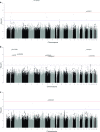Novel susceptibility loci identified in a genome-wide association study of type 2 diabetes complications in population of Latvia
- PMID: 33430853
- PMCID: PMC7802349
- DOI: 10.1186/s12920-020-00860-4
Novel susceptibility loci identified in a genome-wide association study of type 2 diabetes complications in population of Latvia
Abstract
Background: Type 2 diabetes complications cause a serious emotional and economical burden to patients and healthcare systems globally. Management of both acute and chronic complications of diabetes, which dramatically impair the quality of patients' life, is still an unsolved issue in diabetes care, suggesting a need for early identification of individuals with high risk for developing diabetes complications.
Methods: We performed a genome-wide association study in 601 type 2 diabetes patients after stratifying them according to the presence or absence of four types of diabetes complications: diabetic neuropathy, diabetic nephropathy, macrovascular complications, and ophthalmic complications.
Results: The analysis revealed ten novel associations showing genome-wide significance, including rs1132787 (GYPA, OR = 2.71; 95% CI = 2.02-3.64) and diabetic neuropathy, rs2477088 (PDE4DIP, OR = 2.50; 95% CI = 1.87-3.34), rs4852954 (NAT8, OR = 2.27; 95% CI = 2.71-3.01), rs6032 (F5, OR = 2.12; 95% CI = 1.63-2.77), rs6935464 (RPS6KA2, OR = 2.25; 95% CI = 6.69-3.01) and macrovascular complications, rs3095447 (CCDC146, OR = 2.18; 95% CI = 1.66-2.87) and ophthalmic complications. By applying the targeted approach of previously reported susceptibility loci we managed to replicate three associations: MAPK14 (rs3761980, rs80028505) and diabetic neuropathy, APOL1 (rs136161) and diabetic nephropathy.
Conclusions: Together these results provide further evidence for the implication of genetic factors in the development of type 2 diabetes complications and highlight several potential key loci, able to modify the risk of developing these conditions. Moreover, the candidate variant approach proves a strong and consistent effect for multiple variants across different populations.
Keywords: Diabetic complications; Genome-wide genotyping; Type 2 diabetes mellitus.
Conflict of interest statement
The authors declare that they have no competing interests.
Figures


Similar articles
-
Replication study for the association between four Loci identified by a genome-wide association study on European American subjects with type 1 diabetes and susceptibility to diabetic nephropathy in Japanese subjects with type 2 diabetes.Diabetes. 2010 Aug;59(8):2075-9. doi: 10.2337/db10-0067. Epub 2010 May 11. Diabetes. 2010. PMID: 20460425 Free PMC article.
-
Replication study for the association of 3 SNP loci identified in a genome-wide association study for diabetic nephropathy in European type 1 diabetes with diabetic nephropathy in Japanese patients with type 2 diabetes.Clin Exp Nephrol. 2013 Dec;17(6):866-71. doi: 10.1007/s10157-013-0797-5. Epub 2013 Mar 30. Clin Exp Nephrol. 2013. PMID: 23543049
-
A variant within the FTO confers susceptibility to diabetic nephropathy in Japanese patients with type 2 diabetes.PLoS One. 2018 Dec 19;13(12):e0208654. doi: 10.1371/journal.pone.0208654. eCollection 2018. PLoS One. 2018. PMID: 30566433 Free PMC article.
-
Progress in genetics of type 2 diabetes and diabetic complications.J Diabetes Investig. 2023 Apr;14(4):503-515. doi: 10.1111/jdi.13970. Epub 2023 Jan 14. J Diabetes Investig. 2023. PMID: 36639962 Free PMC article. Review.
-
Progress in Defining the Genetic Basis of Diabetic Complications.Curr Diab Rep. 2017 Sep;17(9):80. doi: 10.1007/s11892-017-0906-z. Curr Diab Rep. 2017. PMID: 28779365 Review.
Cited by
-
Insights into the molecular underpinning of type 2 diabetes complications.Hum Mol Genet. 2025 Mar 7;34(6):469-480. doi: 10.1093/hmg/ddae203. Hum Mol Genet. 2025. PMID: 39807636 Free PMC article. Review.
-
Towards prevention of diabetic peripheral neuropathy: clinical presentation, pathogenesis, and new treatments.Lancet Neurol. 2022 Oct;21(10):922-936. doi: 10.1016/S1474-4422(22)00188-0. Lancet Neurol. 2022. PMID: 36115364 Free PMC article. Review.
-
Harnessing Genomic Analysis to Explore the Role of Telomeres in the Pathogenesis and Progression of Diabetic Kidney Disease.Genes (Basel). 2023 Feb 28;14(3):609. doi: 10.3390/genes14030609. Genes (Basel). 2023. PMID: 36980881 Free PMC article. Review.
-
SGLT2 Inhibitors in the Treatment of Diabetic Kidney Disease: More than Just Glucose Regulation.Pharmaceutics. 2023 Jul 20;15(7):1995. doi: 10.3390/pharmaceutics15071995. Pharmaceutics. 2023. PMID: 37514181 Free PMC article. Review.
-
PDE4DIP in health and diseases.Cell Signal. 2022 Jun;94:110322. doi: 10.1016/j.cellsig.2022.110322. Epub 2022 Mar 26. Cell Signal. 2022. PMID: 35346821 Free PMC article. Review.
References
-
- Saeedi P, Petersohn I, Salpea P, Malanda B, Karuranga S, Unwin N, et al. Global and regional diabetes prevalence estimates for 2019 and projections for 2030 and 2045: Results from the International Diabetes Federation Diabetes Atlas, 9th edition. Diabetes Res Clin Pract. 2019;157:107843. - PubMed
MeSH terms
Grants and funding
LinkOut - more resources
Full Text Sources
Other Literature Sources
Medical
Miscellaneous

